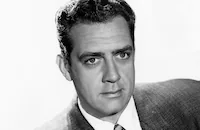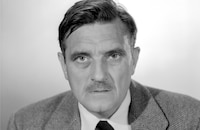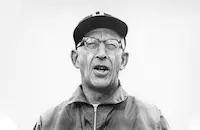Borderline

Brief Synopsis
Cast & Crew
William A. Seiter
Fred Macmurray
Claire Trevor
Raymond Burr
Jose Torvay
Morris Ankrum
Film Details
Technical Specs

Synopsis
Los Angeles policewoman Madeleine Haley is assigned by the police department to uncover evidence against narcotics smuggler Pete Richie. Disguised as a blowzy chorus girl named Gladys La Rue, Madeleine gets a job in a Mexican nightclub frequented by Richie. During the show, she unsuccessfully tries to attract his attention. Later, she makes a play for Deusik, one of Richie's men. After he gets drunk, she helps him back to his room and when he passes out, searches the place. While she is searching the bedroom, Richie enters. She is able to convince him that she was just "freshening up," and he asks her to stay. Suddenly, Johnny Macklin, who works for rival smuggler Harvey Gumbin, breaks into the room and demands information from Richie. When Richie is not forthcoming, Macklin tortures Deusik. A fight breaks out, and Madeleine is forced to shoot Richie in self-defense. Macklin then leaves, taking Madeleine, whom he believes to be Richie's girl friend, with him. Later, Gumbin sends her and Macklin on a dope smuggling run, posing as a honeymooning couple. That night, when they are stopped at a hotel, Macklin and the driver, Miguel, go out for supplies, and Madeleine photographs their fingerprints. Meanwhile, Macklin sends a telegram to the Customs Office, for which he is working undercover, and later photographs Madeleine's fingerprints. In the middle of the night, Richie and his men arrive, bent on revenge. Madeline and Macklin manage to evade Richie, who then lays an ambush for them farther up the road. With the help of some quick thinking by Madeleine, they escape the trap, but Miguel is killed. They abandon their car and get a ride with Porfirio, a farmer, who is also the local sheriff. Meanwhile, the police discover Miguel's body and the abandoned car, and only some fast work by Madeleine forestalls their arrest. Porfirio arranges for a friend to fly Macklin and Madeleine to Ensenada. On the way, they run out of gas and are forced to spend the night on the beach. By morning, Macklin and Madeleine have fallen in love. They finally arrive in Ensenada and are scheduled to cross the border the following day. Each thinks this means he will have to turn the other over to the police. Richie also shows up, and Macklin plots with his contacts to arrest him. After Richie is arrested, Macklin and Madeleine reach the border, where Madeleine is arrested. When she identifies herself as a police officer, however, no one believes her. She then learns that Macklin is a government agent. Finally, Whittaker, Madeleine's boss, arrives and confirms her story. He orders Macklin and Madeleine, who are now both mad at each other, to continue their ruse and meet their contact at the Los Angeles zoo. To Macklin's surprise, Gumbin is revealed to be the head of the operation. They all meet later at Gumbin's house and after a shootout, the smugglers are arrested. Madeleine expresses her relief that Macklin is safe by giving him a big hug.

Director

William A. Seiter
Cast

Fred Macmurray

Claire Trevor

Raymond Burr

Jose Torvay

Morris Ankrum

Roy Roberts

Don Diamond
Nacho Galindo
Pepe Hern
Grazia Narciso
Richard Irving

Charles Lane
Crew
James Anderson
Lucien Andriot
Irene Beshon
Ben Bishop
Milton H. Bren
Milton H. Bren
Norman Cook
Earl Crain
Devery Freeman
Hap Hodges
Cecil Holland
Harry Keller
Don Keyes
Herb Kirkpatrick
Norman Krasna
Howard Lydecker
Theodore Lydecker
Paul Mantz
John Mccarthy Jr.
George Milo
Hans J. Salter
William A. Seiter
Dan Ullman
Howard Wilson
Alfred Ybarra

Videos
Movie Clip



Film Details
Technical Specs

Articles
Borderline
Police woman Madeleine Haley (Claire Trevor), following a lead provided by a smuggler arrested in Los Angeles, goes undercover as a showgirl in Mexico to find the drug supplier with a taste for "cheap blondes" (Raymond Burr) and ends up on the road with American hood Johnny Macklin (Fred MacMurray). The two freelancers team up to smuggle a cache of narcotics over the border, bantering along the way while slipping from wary partners to lovers, neither realizing the other has an ulterior motive.
The low budget production, shot mostly in the California deserts and on anonymous sets playing the cheap hotel rooms and chintzy Mexican nightclub, was produced by Milton H. Bren, a former MGM executive who married Trevor in 1948. The part of Madeleine was perfect for his wife, who was no stranger to tough broads. In such classic film noirs as Murder, My Sweet (1944), Raw Deal (1948), and Key Largo (1948), she played women who had gotten knocked around and scuffed up by life. In the opening scenes of Borderline she comes on more like an excitable cub reporter than a veteran officer and a former O.S.S. agent in her first scenes. At least until she hits Mexico and slips into character as a cheap American bar girl, a woman barely talented enough to land a job dancing in a Mexican nightclub as a chorus girl. Once in character, she rolls with the punches with the best of them, playing the cheap blonde in front of Johnny while snapping evidence with her hidden camera while his back is turned.
Fred MacMurray didn't really fit the gangster type -- in the prime of his leading man career he was usually cast as nice guys in light dramas, romantic comedies, and musicals, and he later turned into America's most beloved dad in the long-running sitcom My Three Sons -- but he could be hardboiled when called for, as in Double Indemnity (1944). His affable personality worked well when cast against type and he brings a matter-of-fact toughness to Johnny, bursting into the film with a gun in his hand, a directness that leans toward torture when interrogation fails, and a side of sardonic commentary delivered through a weary grin.
Before he found fame as Perry Mason on the long-running TV series, Raymond Burr made a specialty of cheap crime bosses and shady shysters, the quintessential slow-speaking heavy who used his bulk, dark eyes, and deep voice to intimidate. But he was more than a B-movie Sydney Greenstreet. Burr's villains suggested the small-time boss playing the big shot, putting on a sneering, arrogant front to cover insecurity and ambition, and hinting at a streak of sadism under his indignation.
Director William A. Seiter began in the silent era and established himself as a comedy specialist, directing the likes of Reginald Denny, Wheeler and Woolsey, Laurel & Hardy, and the Marx Brothers, but like most of his contemporaries became a jack of all trades. He made dramas, romantic comedies, westerns, and musicals, including four Shirley Temple films in the thirties and, more recently, four with Universal Picture sweetheart Deanna Durbin. Borderline is a rare crime drama in his filmography and came toward the end of a busy film career. He made a successful transition to television just a few years later.
He doesn't get a screen credit but film buffs and lovers of classic movies will immediately recognize Charles Lane by face, if not by name, in a small role as the U.S. Customs Agent in the final act. Thin and looking older than his years, this ubiquitous character actor appeared in hundreds of movies and TV shows, usually as miserly old men or cynical, smart-talking professionals, but is probably most recognized for his many Frank Capra films, especially his single scene in It's a Wonderful Life (1946) as Mr. Potter's rent collector.
By Sean Axmaker

Borderline
Quotes
Trivia
Notes
This was the first production of Borderline Pictures, Inc., formed by producer Milton Bren, director-producer William Seiter and actor Fred MacMurray. Although onscreen the story and screenplay are credited to Devery Freeman, production notes attribute the story to Norman Krasna. According to a New York Times article, MacMurray, Bren, Claire Trevor (Bren's wife) and Seiter deferred their salaries to produce the film. This was Bren's first production since Tars and Spars in 1946. Some scenes were shot on location in Malibu, and at Corrigan Ranch and Lasky Mesa, CA. Trevor reprised her role in a Lux Radio Theatre broadcast on October 8, 1951, co-starring Stephen McNally.














